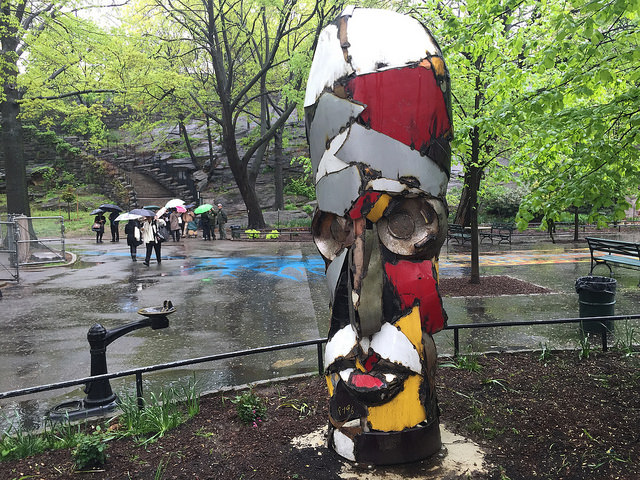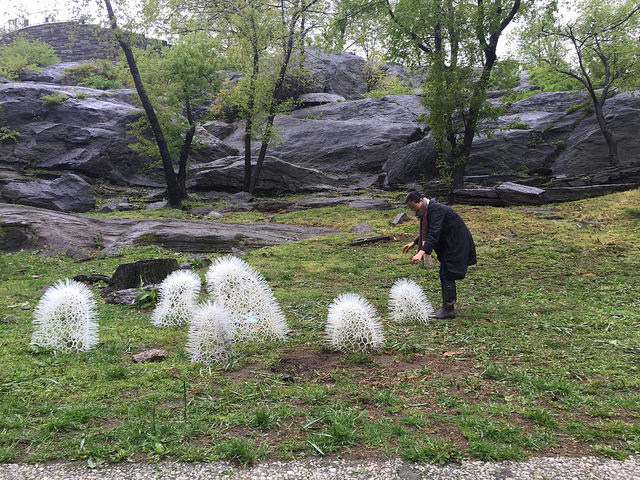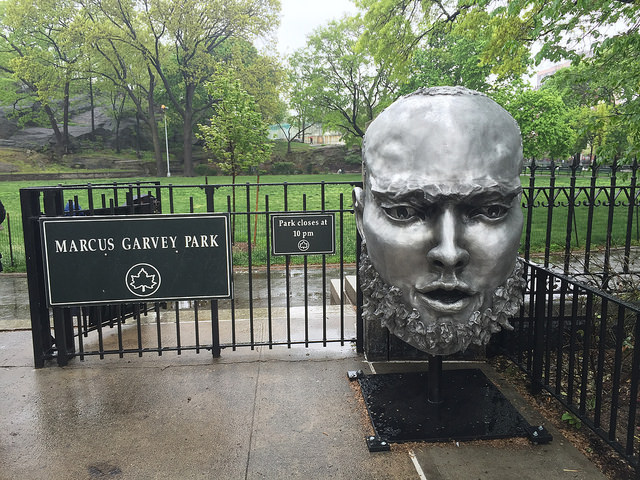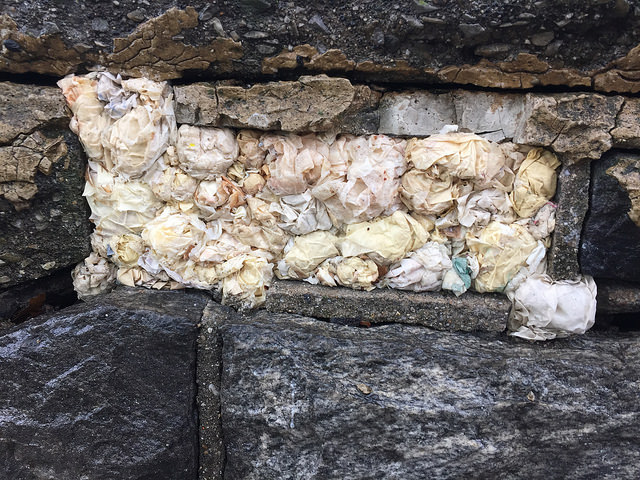
By Leann Garofolo
At the top of a steep, rocky cliff in the vibrantly green Marcus Garvey Park in Central Harlem is a 10-foot-tall spiral sculpture in the shape of a winding DNA helix. Upon closer investigation, this is not just any sculpture; it’s actually embedded with the trash and detritus of objects once found valuable to their human owners. More than a thousand items are lodged into the masterpiece, with trinkets ranging from children’s toys, to cigarette containers, to abandoned BlackBerry cellphones.
The statue is called “DNA Totem,” and it was expertly crafted over the course of one year by New York-based sculptor, Suprina Kenney. It is one of 40 art installations that can be found around the park, which borders 5th Avenue, as well as on boulevards in Harlem as part of the Flux Art Fair. The art created was in response to this year’s theme of “Changing Landscapes,” whether it be physically or metaphorically in the neighborhood of Harlem and beyond.
“I wanted to do a piece that was relating us to our trash, to what we throw away,” said Kenney, a New York-based sculptor. “[I] did a little spin on it, and asked a question, is it in our actual DNA to be so destructive to our own environment?”
Neighborhood destruction is something longtime Harlem residents know a lot about.
After living in Harlem for many years, Terrance Heyward moved to Baltimore, Maryland, for work, but he frequently comes back to visit. He was walking through the park recently when he stopped and admired the art work.
Heyward said Harlem has only changed for the better in the 10 years since he moved. Vacant houses, open lots, crime and drug activity were rampant throughout the neighborhood. The park used to be littered with crack vials and parents would not bring their children there. Heyward was happy to see art showcased instead.
“Before with all the illegal activity and the violence and stuff like that that was going on in the 80’s and 90’s, [it] made it difficult for people to see what Harlem is actually made of,” he said.
The Marcus Garvey Park Alliance was established in the late 1990’s in an effort to stop illegal activities occurring around the park that were keeping local residents out. Now, it is a safe environment that holds many of the neighborhood’s cultural events, attracting locals as well as new audiences.

Sui Park tends to her “Sprout” installation on a rainy day in Harlem. By Leann Garofolo
The 20-acre park has a rocky schist cliff standing tall in the center, interrupting the flow of Fifth Avenue traffic. It expands from 120th Street to 124th Street with Madison Avenue on its east side. A recreation center, a community pool, basketball courts, and playgrounds are just some of the features that surround the towering cliffs.
This year, many artists used the various landscapes of the park to integrate their works, a symbol of preserving Harlem while acknowledging the past and present. For nearly a century, Harlem was known as a predominantly black neighborhood that dramatically shaped urban culture. Now, with the population of the black community being the lowest it has been since the 1920’s, gentrification is altering the community’s identity, skyrocketing rent prices and commercializing an area that used to be home to local mom and pop shops.

An art installation by Bob Clyatt is installed at one of the entrances to Marcus Garvey Park. Photo by Leann Garofolo
Amy Sinclair, a white artist living on the Upper West Side, was taking a walk around the park to view the installations on opening day.
“We know that gentrification is just a really major issue in the city right now, all over the place,” Sinclair, a Bronx native said. “And from the point of view of an artist, I definitely have a sensitivity and a long term awareness of how artists play into the process of gentrification.”
Sinclair said that Harlem’s strong community and powerful legacy make artists aware of the issues that exist, and that “art is in a kind of dance with [gentrification] and there’s ways for it to be resistant to it.”
“It’s a complicated issue,” she said, but knowing the history of Harlem can make artists have a more “engaged, positive impact” on the art in the community.
A Flux artist who understood that importance of Harlem’s history was Capucine Bourcart. Originally from Alsace, France, she moved to Harlem 10 years ago. She wanted to create a piece that would link modern day park visitors to their ancestors.
Bourcart’s installation, called “Trompe l’oeil,” or “visual illusion in art” used small metal prints to design a pattern inspired by the clothing of the Lenape tribe, the first population to live on Marcus Garvey Park. The print on the metals were made from photos Bourcart took of different Manhattan walls. They hung in a diamond shape on the fence surrounding the baseball field, creating a tribal pattern.
“I think where you are living, you need to know a bit of the history,” she said. “You need to know where you come from [because] you would need to know where you are going.”
Other art installations acknowledged the physical and cultural evolution of the community.
In “Fillings (Brickolage)”, artist Jeffrey Allen Price, of Long Island, N.Y. used household materials such as broken egg shells, masking tape, and dryer lint to fill in broken or dilapidated bricks around the Acropolis area of the park. The temporary “fillings” are a reminder that while the walls have broken down and need repair, the beauty of the existing infrastructure can still be recognized.

Household materials are used to fill broken down bricks in Marcus Garvey Park. Artist Jeffrey Allen price expertly filled this brick using different kinds of tape. By Leann Garofolo
“It’s preservation, it’s recognition of what’s here, because it’s not taking it down,” said Flux Art Fair founder, Leanne Stella, of the installation. “It’s becoming part of what’s already here.”
Another artist who strove to embrace the changing neighborhood of Harlem was Jordan Baker-Caldwell in an installation called “Golem”. The 10-foot sculpture is an abstract face made out of used pieces of scrap metal taken from taxis, Ford trucks, vans, and metal woks from Chinatown. According to Baker-Caldwell, the varied colors and metals portray the evolution of cultures in Harlem.
“To me, it is kind of representative of that changing face of Harlem,” said Baker-Caldwell, a sculptor who was born and raised in the city. “That idea of ‘from the old to the new.’ So, it’s things still being of the past, still having some of the flavor of the past, but then also growing into something new.”
Not only do the art installations embrace the changing landscapes of Harlem, but they also make art accessible to everyone in the community.
Lusia Moskvicheva moved to Harlem three years ago with her husband and son after 15 years in the the West Village. Although she sometimes missed the small village feel of her old neighborhood, things like newly installed art in Marcus Garvey Park made her feel right at home.
“I do like bringing more art [to Harlem] because, you know, Chelsea and the galleries are far away,” she said. “I think it’s absolutely a good thing. It just means that people care about it.”
Moskvicheva is a member of various art museums, including MoMA, so she is able to visit anytime she wants. Distance from the artistic community was not a “make or break” factor of moving to her new neighborhood, but she understood that others may not be so lucky.
“I love the people and I like the sense of community here. It’s a big melting pot racially, financially, you know,” said Moskvicheva. “I think for people who don’t have access to [art], it’s fantastic.”
Some locals hoped art would make Harlem more appealing to those who are hesitant to visit the upper Manhattan neighborhood.
Vincent Anderson from the Tremont section of the Bronx often visits Harlem to compete in chess tournaments with his friends. He noticed the art installations and thought they were a great way to bring the park back. He would like to see local artists become a permanent fixation in public spaces.
Since Harlem is making a “cultural comeback,” Anderson said he would consider one day relocating to Harlem, but above all, “what would be prohibitive is the rent” prices. He was not the only one who thought public art made the community feel more approachable.
“Them doing this is a wonderful thing, because it brings in a lot more tourists,” said Heyward. “They’re not afraid to come here and lets them know that it’s okay to come to Harlem now.”